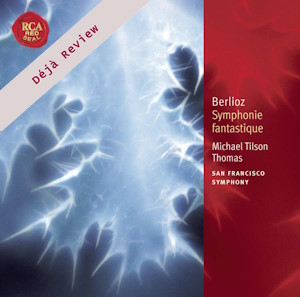
Déjà Review: this review was first published in November 2004 and the recording is still available.
Hector Berlioz (1803-1869)
Symphonie fantastique, Op. 14 (1830)
Lélio où Le Retour à la vie, Op. 14bis (excerpts) (1832)
San Francisco Symphony/Michael Tilson Thomas
rec. 1998, Davies Symphony Hall, San Francisco
RCA Red Seal 82876 608592 [76]
What can be said about Berlioz’s Symphonie fantastique that hasn’t been said a thousand times? It is one of the great masterpieces of symphonic literature, perfectly refined and elegant at times, yet straining to burst with its explosive intensity. It was written by a young man, not yet 30, as his first symphony.
It tells a story of love, as so many great pieces do. The opening movement has the protagonist falling in love with a woman whose theme remains throughout the work. The second movement has our young man finding himself disturbed by the image of his beloved at a ball. The third movement finds him in between comfort with her and a suspicion that she is deceiving him in some way. The fourth movement finds the young man sick on opium and dreaming that he has murdered his beloved. Finally the last movement reinvents the idée fixe into a distorted theme of funeral music and orgiastic passion.
With no disrespect to Mahler or Shostakovich, it is quite possibly the best ever first-symphony.
On this recording, the symphony is followed by two movements from one of Berlioz’s lesser works. Lélio ou Le Retour à la vie is an enjoyable piece with echoes of the Symphonie fantastique’s energy, wit and vitality. It is, however, more of a theater piece than a musical one. Berlioz originally intended the orchestra to be hidden behind a curtain during the performance. The protagonist, Lélio, is a broken man who is recovering from opium addiction and goes through the personal turmoils of personal injustices and failure in love. Finally he ponders redemption through art.
There are two selections from this work. The first is an adaptation by Berlioz of his own cantata La Mort de Cléopâtre, and is an intensely dramatic piece. The choir broods and explodes in turns throughout this rather dark and melodramatic work. The second selection is a fantasia based on William Shakespeare’s The Tempest. While it works through a great many moods and takes several turns, it finalizes in a rambunctious blast towards the conclusion. We are able to see Lélio energized and optimistic as the work closes on an up-note.
Michael Tilson Thomas and the San Francisco Symphony do a wonderful job of capturing the flavor and flair of the Symphony. Thomas is well suited to the extroverted and extravagant world of Berlioz’s music. He too has a penchant for the fantastic tempered with an attention to detail and rootedness derived from an artistic life.
The performance was approached with a great deal of sympathy and understanding, as well as a nearly ribald virtuosity exploding from the symphony. Their virtuosity is clean and unquestionable. The technical work on the recording is very good, using the 24 bit sound resolution to its fullest. The recording is well done and among the better recordings.
As a rule of thumb, it is difficult to highly recommend a particular recording of a work that has been recorded as often as the Symphonie fantastique. However, this is a rendition that deserves to be heard. If you don’t have a favorite recording already, this is a disc that you should consider.
Patrick Gary
Help us financially by purchasing from


















